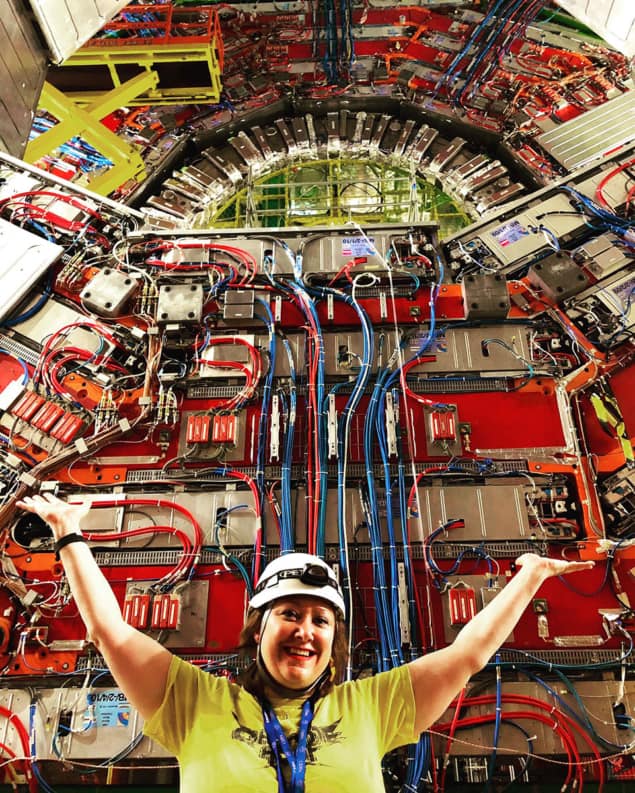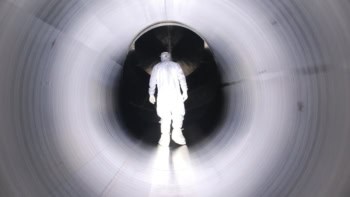Experimental physicist Freya Blekman talks to Tushna Commissariat about the joy of working on big science collaborations

As an experimental particle physicist and lead scientist at DESY, Germany’s largest accelerator centre, Freya Blekman hopes to answer some of the big questions in physics. With a professorship at the University of Hamburg, she works on the Compact Muon Solenoid (CMS) detector at the Large Hadron Collider (LHC) at CERN, where she is also the lead physics communications officer. Having been involved in large collaborations everywhere from Fermilab in the US to Imperial College in the UK, she talks to Tushna Commissariat about her unique career path.
What sparked your initial interest in science and physics?
I have always been interested in science. As a child, I was obsessed by insects, but also by the ancient Egyptians, and I would read encyclopaedias, just to gather knowledge. I think the idea that I might have a career in science was perhaps clear to others around me even then. In particular I remember a school play when I was 11. It was written by my teacher who assigned us all different roles, and I was the scientist. I come from a relatively arts and social-sciences oriented family background, though my grandmother was extremely maths-oriented. Unfortunately, she was forced to quit studying after high-school to support her brother, who ended up becoming a professor. So she definitely cared that I went university, and pursued the sciences.
By secondary school I knew that I was going to do something scientific – the question really was what. I had initially decided to study biology, but switched to physics two weeks before I started university, after running into my physics teacher in the street, who convinced me to pick the subject.
What led you to doing a PhD in particle physics?
To be completely honest, I was not a stellar student. I also had to contend with some family issues – both my parents passed away during my studies, two years apart – so my time at university was not easy. I think that if some of the rules that are now enforced – such as very hard cut-offs and constraints about only admitting ideal students – had applied to me, I wouldn’t have got my degree. I didn’t know it at the time, but now that I work in academia, I realize that there were people who likely lobbied for me.
When I started out at the University of Amsterdam, I wanted to study biophysics. But then the university organized a trip to CERN, which made a huge impression on me. By the time I completed my Master’s in 2000, my thesis was based on the LHCb experiment at CERN.
After having been a CERN summer student in 1999, I realized that I enjoy the research lifestyle. From there, I ended up in a particle physics PhD programme and in the very first week, I was sent to the US for a workshop. I ended up doing most of my doctorate at Fermilab, where the University of Amsterdam sent me, to work on the DZero (DØ) experiment, which, at the time, had just detected the top quark.
How did you plan what to do after your PhD?
I’m a relatively social person and I enjoy working with others, so I think that I fit quite well into a collaborative science environment. I was very lucky during my PhD to work with some excellent people who all eventually became faculty themselves.
Finding a postdoc was not particularly difficult – I applied to multiple places and in the end I chose my postdoc based on location and prestige. I wanted to live in big cities, and so I chose Imperial College, London. That part of my career was a bit of shock because coming from the Dutch academic system, and going into the British one was quite a change. By now though, I have embraced it. I’m in Oxford as we speak, where I give yearly lectures on physics in the top quark sector, at the University of Oxford’s doctoral school.
But of course it was quite different at that time, especially because I was effectively the only woman in a group of 100 people. Until then, I had always been “one of the boys” and didn’t really think that gender issues were a problem for me. But when you are put in that position, you start to re-evaluate. Fortunately since I worked there in the 2000s, Imperial has really improved in that aspect.
I considered leaving academia and going into industry at the end of the postdoc, but ultimately decided to remain in fundamental research. For my second postdoc, 2007–2010, I was a research associate at Cornell University in the US, but was based at CERN and working on the CMS. I was given a lot of responsibility there, and it was a very exciting time because this was exactly when the LHC was turning on. We were finally getting data and could do the physics, so it was thrilling, but hard work.
What was it like being at CERN for the Higgs discovery?
The actual announcements were interesting because I was one of the many people in Australia at the International Conference of High Energy Physics, watching the announcement via video-link. I was aware of the CMS results and it was amazing to finally see that ATLAS too had consistent data.
The day was fantastic, but detecting the Higgs boson was a bit of a double-edged sword. While it was great to discover something we had long been looking for, it was another triumph for the Standard Model – even though it has its weaknesses, such as no explanation for dark matter. In a way it might have been a lot more exciting if we had not found the Higgs particle.
It’s indisputable that the Standard Model cannot be the whole picture
Freya Blekman
As the amount of data that the LHC produces keeps increasing exponentially, it’s important to remember that we found the Higgs with less than 1% of the data having been examined. Even now, we are at 3% of the data; there is a lot more coming. And claiming that there’s nothing there before you’ve even looked at this data isn’t right. It’s indisputable that the Standard Model cannot be the whole picture, but the real question is whether there are explanations to be found in the vast amounts of LHC data still to be examined.
What’s a ‘day in the life’ like for you now?
As a professor, there is a lot of organization, management and helping students, as well as a great deal of admin, hiring people and peer review. I’m also responsible within the CMS collaboration for the communication of any results to the general public and to the press. And occasionally I get to do some research myself – I really try to save at least half a day a week for this.
Sometimes the faculty job is perfect for me, as I get to brainstorm with young enthusiastic people. Other times, it is very intense; particularly working in large collaborations, with deadlines and competition. It can be really cutthroat every so often, so you have to protect yourself and the people in your team. I consider managing the well-being and mental health of everyone on my team an important part of the job, which is challenging at times.
What is your advice to students today hoping to get into high-energy particle physics?
Be willing to learn and don’t assume you know everything. Work with people who are complimentary to you. The nice thing about particle physics is that it’s extremely broad. You can do anything from quantum-field theory calculations, all the way to welding. I think that a good particle physicist knows more than just code and how to do analysis. An experimentalist should be able to build a detector but also innovate on the theoretical side – that’s an important thing early-career people can forget.
This can be related to the phases of the LHC or any other accelerator. When there’s data coming in, you can’t work on the device. But it is really important that you recognize that the people who have a deep, intimate knowledge of the detector can do some innovative interpretation of the data because they can squeeze out that final per cent of data that you need to get your result.



